#Upper Triassic fish fossil
Explore tagged Tumblr posts
Photo

Fossil Fish Tooth in Block Upper Triassic Westbury Formation Aust Cliff Bristol UK Authentic Specimen
This listing features a fossil fish tooth, carefully preserved in a block of sediment from the renowned vertebrate and coprolite bed at Aust Cliff, near Bristol, UK. The fossil was recovered from the Westbury Formation, part of the Penarth Group, and dates to the Upper Triassic Period (Rhaetian Stage, ~208–201 million years ago).
The specimen was discovered by our own UKGE team members, Alister and Alison, on 07 April 2025, and has been cleaned, prepped and treated by Alison. It is provided with a Certificate of Authenticity, and the photo shows the exact specimen you will receive.
Geological Context:
The Westbury Formation was laid down in a shallow marine to lagoonal environment, famous for its exceptional preservation of vertebrate remains, including fish, marine reptiles, and coprolites. Aust Cliff is one of Britain’s most scientifically important Triassic sites, offering an exceptional glimpse into marine ecosystems just before the Triassic-Jurassic extinction event.
Species Information:
While individual teeth are often difficult to attribute to a specific genus without more context, they are commonly assigned to bony fish such as Saurichthys, Severnichthys, or early actinopterygians known from this formation. These species are characterised by:
Elongate, conical teeth
Smooth enamel with minimal ornamentation
Adaptations for a carnivorous diet
Morphological Features:
Conical, pointed shape with slight curvature
Well-preserved enamel surface
Tooth embedded in micaceous dark-grey mudstone matrix
Possible presence of associated fish scale or coprolitic fragments nearby
Specimen Details:
Fossil Type: Fish Tooth in Matrix Block
Geological Formation: Westbury Formation
Group: Penarth Group
Geological Stage: Rhaetian (Upper Triassic)
Location: Aust Cliff, Bristol, UK
Depositional Environment: Shallow marine to lagoonal
Discovered By: Alister & Alison (UKGE Team)
Date of Discovery: 07 April 2025
This specimen is a fantastic addition to any vertebrate palaeontology collection and serves as a window into one of the most significant geological intervals in Earth’s history.
Scale cube = 1cm. Please refer to the image for full sizing and preservation detail.
All of our Fossils are 100% Genuine Specimens & come with a Certificate of Authenticity.
#fossil fish tooth Aust Cliff#Upper Triassic fish fossil#Westbury Formation fossil#Penarth Group vertebrate fossil#Aust Cliff coprolite bed tooth#Triassic fish remains UK#real fossil fish tooth#Aust Cliff fish block#Rhaetian Stage fossil fish#marine vertebrate fossil UK#fossil with certificate#fossil fish enamel tooth#UKGE team fossil discovery#Bristol Triassic fossil#Penarth Group fossil specimen
0 notes
Text
Round 3 - Chondrichthyes - Chimaeriformes




(Sources - 1, 2, 3, 4)
Our last order in Chondrichthyes is Chimaeriformes, commonly known as “Chimaeras”, and informally known as “ghost sharks”, “spookfish”, “rabbitfish”, or “rat fish” (not to be confused with the Actinopterygiian “rattails”.) Historically a much more diverse and abundant group, they now only comprise the living families Callorhinchidae (“plough-nosed chimaeras” or “elephantfish”), Chimaeridae (“short-nosed chimaeras”), and Rhinochimaeridae (“long-nosed chimaeras”).
Chimaeras are soft-bodied, with bulky heads and long, tapered tails. Their pectoral fins are large enough to generate lift at a relaxed forward momentum, similar to a kite, giving the chimaera the appearance of "flying" through the water. Their gill arches are condensed into a pouch-like bundle covered by an operculum with a single gill-opening in front of the pectoral fins, similar in appearance to Actinopterygiians. They lack spiracles. There are two dorsal fins: a large triangular first dorsal fin and a low rectangular or depressed second dorsal fin. For defense, some chimaeras have a venomous spine on the front edge of the dorsal fin. In many species, the bulbous snout is modified into an elongated sensory organ, capable of electroreception to find prey. Instead of many sharp, consistently-replaced teeth, chimaeras have just six large, permanent tooth-plates, which grow continuously throughout their entire life. These tooth-plates are arranged in three pairs, with one pair at the tip of the lower jaws and two pairs along the upper jaws. They together form a protruding, beak-like crushing and grinding mechanism, comparable to the incisor teeth of rodents and lagomorphs. Most living species are native to the deep sea, with some species inhabiting depths exceeding 2,000 m (6,600 ft) deep, though the few exceptions include the shallower-dwelling plough-nosed chimaeras (genus Callorhinchus) (image 2), the Rabbit Fish (Chimaera monstrosa), and the Spotted Ratfish (Hydrolagus colliei) (image 3).
Chimaeras have separate anal and urogenital openings, rather than a single cloaca. Like sharks and rays, male chimaeras utilize claspers for internal fertilization of females, but unlike sharks and rays, also have retractable sexual appendages known as tentacula to assist in mating. The frontal tentaculum, a bulbous rod which extends out of the forehead, is used to clutch the females' pectoral fins during mating. The prepelvic tentacula are serrated hooked plates normally hidden in pouches in front of the pelvic fins, and they anchor the male to the female. Their claspers are fused together by a cartilaginous sheathe before splitting into a pair of flattened lobes at their tip. Females lay their eggs within spindle-shaped, leathery egg cases which they deposit on the sea floor.
As the most ancient of the Chondrichthyans, Chimaeriformes are truly deserving of the moniker “living fossil”. They have been around since the Early Carboniferous, with the earliest known fossil species being Protochimaera, and split off from the sharks and rays during the Devonian. Modern chimaeras are known from the Early Jurassic, but fossil egg cases from the Late Triassic resembling those of rhinochimaerids and callorhinchids indicate that they had a global distribution earlier than this. Modern chimaeras reached their highest ecological diversity during the Middle Cretaceous. Recent studies indicate that chimaeras were likely a shallow-water group for most of their existence, and only fled to deeper waters in the aftermath of the K-Pg extinction event, adapting to the deep sea to survive.

Propaganda under the cut:
Some chimaera venom can cause pain, necrosis, hallucinations, and localized paralysis in humans. It is not deadly to humans, but has been known to kill Harbor Seals that injested Spotted Ratfish (Hydrolagus colliei).
Spotted Ratfish (Hydrolagus colliei) have large, emerald green eyes, which are able to reflect light, similar to the eyes of a cat.
Chimaera teeth are unique among vertebrates, due to their mode of mineralization. Most of each plate is formed by relatively soft osteodentin, but the active edges are supplemented by a unique hypermineralized tissue called pleromin, rather than enamel. Pleromin is an extremely hard enamel-like tissue, arranged into sheets or beaded rods, but it is deposited by mesenchyme-derived cells similar to those that form bone. In addition, pleromin's hardness is due to the mineral whitlockite, which crystalizes within the teeth as the animal matures.
The Australian Ghostshark (Callorhinchus milii) is very popular with fish-and-chips restaurants in New Zealand and is sold as 'flake' or 'whitefish' in Australia.
The Striped Rabbitfish (Hydrolagus matallanasi) can see in total darkness and sense electromagnetic radiation (outside of the visible spectrum) emitted by other marine creatures due to exposed nerves on the sides of its body.
Some species of chimaerids are known to segregate by sex, with females congregating at greater depths than males.
Despite their deep sea habitat and reclusive nature, some chimaera species are still threatened by bycatch due to deep sea trawling for demersal shrimp and prawns. Even when released, most chimaeras do not survive the process of being quickly pulled up from the pressurized deep sea to shallower water.
#description a bit longer than usual because they’re so unlike all the other members of the class#animal polls#round 3#chondrichthyes
102 notes
·
View notes
Text
From Peasant Fodder To Posh Fare: How Snails And Oysters Became Luxury Foods
— Beth Daley | The Conversation | May 22, 2025

An Oyster cellar in Leith. John Burnet, 1819; National Galleries of Scotland, Photo: Antonia Reeve
Oysters and escargot are recognised as luxury foods around the world – but they were once valued by the lower classes as cheap sources of protein. Less adventurous eaters today see snails as a garden pest, and are quick to point out that freshly shucked oysters are not only raw but also alive when they are eaten. How did these unusual ingredients become items of conspicuous consumption?
From Garden Snail To Gastronomy
Eating what many consider to be a slimy nuisance seems almost counter-intuitive, but consuming land snails has an ancient history, dating to the Palaeolithic period, some 30,000 years ago in eastern Spain. Ancient Romans also dined on snails, and spread their eating habits across their empire into Europe. Lower and middle class Romans ate snails from their gardens, while elite consumers ate specially farmed snails, fed spices, honey and milk.

An Ancient Roman mosaic dating to the 4th century AD depicting a basket of snails, Basilica di Santa Maria Assunta, Aquileia, Italy. Carole Raddato/Wikimedia Commons, CC BY-SA
Pliny the Elder (AD 24–79) described how snails were raised in ponds and given wine to fatten them up. The first French recipe for snails appears in 1390, in Le Ménagier de Paris (The Good Wife’s Guide), but not in other cookbooks from the period.
In 1530, a French treatise on frogs, snails, turtles and artichokes considered all these foods bizarre, but surprisingly popular. Some of the appeal had to do with avoiding meat on “lean” days. Snails were classified as fish by the Catholic Church, and could even be eaten during Lent.
For the next 200 years, snails only appeared in Parisian cookbooks with an apology for including such a disgusting ingredient. This reflected the taste of upper-class urbanites, but snails were still eaten in the eastern provinces.

Schneckenweib, or Snail Seller, illustrated by Johann Christian Brand in Vienna, after 1798. Wien Museum
An 1811 cookbook from Metz, in the Alsace region in northeastern France, describes raising snails like the Romans, and a special platter, l'escargotière, for serving them. The trend did not travel to Paris until after 1814.
French diplomat Charles-Maurice de Talleyrand-Périgord (1754–1838) hosted a dinner for Russian Tsar Alexander I, after he marched into Paris following the allied forces’ defeat of Napoleon in 1814. The chef catering the meal was the father of French cuisine Marie-Antoine Carême, a native of Burgundy, spiritual home of the now famous escargots de Bourgogne.
Carême served the Tsar what would become a classic recipe, prepared with garlic, parsley and butter. Allegedly, the Tsar raved about the “new” dish, and snails became wildly popular. A recipe for Burgundy snails first appeared in a French culinary dictionary published in 1825.
It is ironic that it took the approval of a foreign emperor, who had just conquered Napoleon, to restore luxury status to escargot, a food that became a symbol of French cuisine. Snails remain popular today in France, with consumption peaking during the Christmas holidays, but May 24 is National Escargot Day in France.
Oysters: The Original Fast Food
Oysters are another ancient food, as seen in fossils dating to the Triassic Era, 200 million years ago. Evidence of fossilised oysters are found on every major land mass, and there is evidence of Indigenous oyster fisheries in North America and Australia that dates to the Holocene period, about 12,000 years ago.
There are references in classical Greek texts to what are probably oysters, by authors like Aristotle and Homer. Oyster shells found at Troy confirm they were a favoured food. Traditionally served as a first course at banquets in Ancient Greece, they were often cooked, sometimes with exotic spices.

Music-cover sheet for ‘Bonne-Bouche’ by Emile Waldteufel, 1847-1897. © The Trustees of the British Museum, CC BY-NC-SA
Pliny the Elder refers to oysters as a Roman delicacy. He recorded methods of the pioneer of Roman oyster farming, Sergius Orata, who brought the best specimens from across the Empire to sell to elite customers.
Medieval coastal dwellers gathered oysters at low tide, while wealthy inland consumers would have paid a premium for shellfish, a perishable luxury, transported to their castles.
French nobles in 1390 preferred cooked oysters, roasted over coals or poached in broths, perhaps as a measure to prevent food poisoning. As late as the 17th century, authors cautioned:
But if they be eaten raw, they require good wine […] to aid digestion.

Oyster Seller, Jacob Gole, 1688–1724. Rijksmuseum
By the 18th century, small oysters were a popular pub snack, and larger ones were added as meat to the stew pot. That century, it is believed as many as 100,000 oysters were eaten each day in Edinburgh and the shells from the tavern in the basement filled in gaps in the brickwork at Gladstone’s Land in Edinburgh’s Royal Mile.
Scottish oyster farms in the Firth of Forth, an inlet of the North Sea, produced 30 million oysters in 1790, but continual over-harvesting took its toll. By 1883 only 6,000 oysters were landed, and the population was declared extinct in 1957.
As wild oyster stocks dwindled, large oyster farms developed in cities like New York in the 19th century. Initially successful, they were polluted, and infected by typhoid from sewage. An outbreak in 1924 killed 150 people, the deadliest food poisoning in United States history.

Costumes of Naples: Oyster Sellers, c. 1906–10. Rijksmuseum
Far from the overabundance of oysters we once had, over-fishing, pollution, and invasive species all threaten oyster populations worldwide today. Due to this scarcity of wild oysters and the resources required to safely farm environmentally sustainable oysters, they are now a premium product.
Next On The Menu
Scarcity made oysters a luxury, and a Tsar’s approval elevated snails to gourmet status. Could insects become the next status food? Ancient Romans ate beetles and grasshoppers, and cultures around the world consume insects, but not (yet) as luxury products. Maybe the right influencer can make honey-roasted locust the next species to jump from paddock to plate.
#TheConversation.Com#Beth Daley | Executive Editor ✍️ | General Manager#Peasant Fodder#Posh Fare#Snails 🐌🐌🐌#Oysters 🦪🦪🦪#History#Food 🍲🍱🥘#Food History
0 notes
Text
I've recently discovered the Prehistoric Nature mod for Minecraft and it's really great. You can build portals to dimensions representing eight different periods in Earth's history and they're just full of Creatures going about their business as well as era-appropriate plants and sessile animals. Not just the well-known ones, but also loads of more obscure weirdos. Right now you can visit each of the six Paleozoic periods, the Triassic, and a sort of odd Precambrian mashup dimension (Ediacaran life under Cryogenian sea ice, while the land is full-on Hadean). You can catch and breed, and even cook and eat the animals if you feel so inclined. In Survival mode, there's a lot of content around digging for plant fossils to even get the portals in the first place added too. Let me just share some random screenshots I took while looking around.

Moschops hanging out on a frosty Permian beach.

A little edaphosaurid I stumbled upon in the Carboniferous.

Fire spreads faster in the Carboniferous, so a bit of natural lava caused a massive blaze.

This biome is called 'Silurian lush patch'. 'Lush' is a very relative term in the Silurian.

Underwater everything is gorgeous though.

A view over a Triassic lake, including some Plateosauruses at the upper right.

A large lobe-finned fish I encountered in some Devonian shallows.
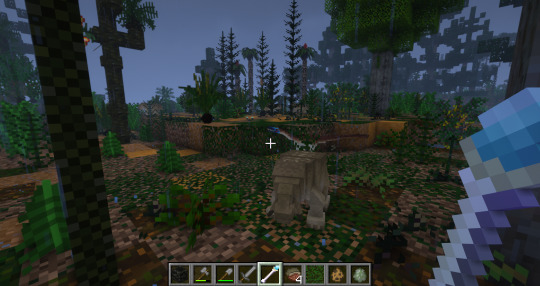
Placerias and Coelophysis.
#minecraft#prehistoric nature mod#there's so many friends wandering about#also it gets regularly updated#the triassic was only added a few days ago#and in the same update the silurian and ordovician which used to share a dimension got divorced#silurian took the kids#they're working on adding the jurassic next#palaeoblr
8 notes
·
View notes
Text
Nothosaurus
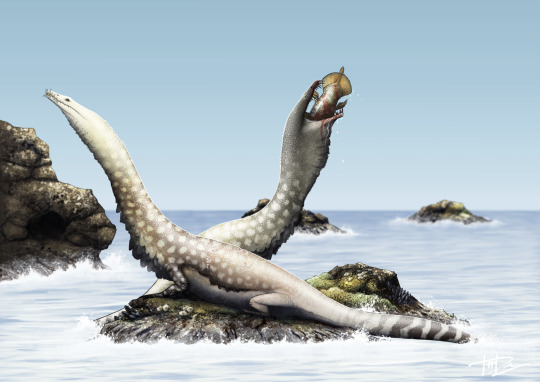
By Tas Dixon
Etymology: False Reptile
First Described By: Münster, 1834
Classification: Biota, Archaea, Proteoarchaeota, Asgardarchaeota, Eukaryota, Neokaryota, Scotokaryota, Opimoda, Podiata, Amorphea, Obazoa, Opisthokonta, Holozoa, Filozoa, Choanozoa, Animalia, Eumetazoa, Parahoxozoa, Bilateria, Nephrozoa, Deuterostomia, Chordata, Olfactores, Vertebrata, Craniata, Gnathostomata, Eugnathostomata, Osteichthyes, Sarcopterygii, Rhipidistia, Tetrapodomorpha, Eotetrapodiformes, Elpistostegalia, Stegocephalia, Tetrapoda, Reptiliomorpha, Amniota, Sauropsida, Eureptilia, Romeriida, Diapsida, Neodiapsida, Sauria, Archosauromorpha?, Archelosauria, Pantestudines, Sauropterygia, Eosauropterygia, Nothosauria, Nothosauridae, Nothosaurinae
Referred Species: N. mirabilis, N. cristatus, N. cymatosauroides, N. edingerae, N. giganteus, N. haasi, N. jagisteus, N. marchicus, N. mirabilis, N. tchernovi, N. yangjuanensis, N. zhangi
Time and Place: From 242 million years ago until 208 million years ago, from the Ladinian of the Middle Triassic through the earliest Rhaetian of the Late Triassic
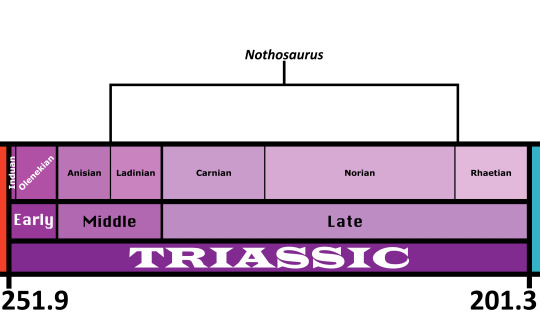
Nothosaurus is known from all over Eurasia and North Africa, to the point that it’s pointless to list all the locations. Just assume that if it’s the Mid or Late Triassic of the Tethys Sea, Nothosaurus is there.
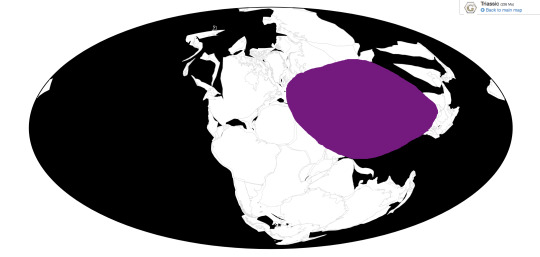
Physical Description: Nothosaurus is an iconic Triassic marine reptile - to the point that we had to include it, or else we would have violated some sort of rule of paleontology. Nothosaurus was about 4 meters long on average, but could reach up to 7 meters in length. It had a long, streamlined body, with a long neck and a long tail. Its head was narrow and filled with long and pointed teeth which interlocked together when the mouth closed, forming a tight trap. Its forelimbs were longer than its hind limbs, and all of its hands and feet had webbing between the long toes. In a lot of ways, it looked extremely similar to later marine reptiles to which it was closely related, like the Plesiosaurs and Pliosaurs, just with hands instead of proper flippers - however, current evidence indicates that the Plesiosaurs and Pliosaurs evolved from an ancestor of both groups, and Nothosaurus is just a Triassic offshoot. It had capabilities for diving in the water, though it also was still adapted for life on the shore.
Diet: Nothosaurus primarily ate fish and other marine animals, including other marine reptiles.
Behavior: Nothosaurus was semi-aquatic, spending a lot of its time both in the ocean and on land. On the beaches and shores it would rest and sleep, and then turn to the ocean for most of its everyday life. Diving for food would have been most of its daily activities, going after juvenile reptiles and large fish in the water and diving in order to reach it. It probably would have paddled with its webbed feet, and undulated its body to some extent to help propel forward. It may have been at least somewhat social, living in groups and colonizing the shores together before going for group dives for food. Interestingly enough, Nothosaurus was basically like a reptilian seal, coming up to shore to rest and sit with its relatives. Whether or not they would have given birth to live young is uncertain; while their close relatives, the Plesiosaurs, did; they retained enough land adaptations to allow them to lay eggs on the shore. More research as to their physiology is needed in order to determine that aspect of their life history. Trackways have been attributed to Nothosaurus, which may show that they rowed their paddles on the sea bed to shake up small animals trapped underneath; this would have allowed Nothosaurus to capture the invertebrates between its long teeth and hold onto them so they could not escape.
Ecosystem: Nothosaurus lived throughout the early Tethys sea, and was a common feature in many communities throughout this growing body of water during the Middle and Late Triassic. It would have stuck to the coasts for the most part, but still ventured out into deep and open water. As such, it’s rather difficult to list all the different animals it lived alongside - it’s found in Bulgaria, China, France, Germany, Hungary, Israel, Italy, Jordan, the Netherlands, Poland, Saudi Arabia, Spain, and Switzerland. So just, assume that a marine creature from the Tethys during this time lived with Nothosaurus rather than not.
Other: Nothosaurus has been treated as, unfortunately, a wastebasket taxon - it was discovered early enough in the history of paleontology as a science that many similar animals were just dumped into this name without any specific studies done. So, determining the factual relationships from this mess is still being worked out; in fact, it seems that this genus is paraphyletic, with many close relatives of Nothosaurus being more closely related to some species than to others. So that’s fun!
Species Differences: The varying species of Nothosaurus tend to differ based on where and when they lived, rather than any particularly notable differences. There are some differences in size and limb proportions as well, but in general the differing species of Nothosaurus would have had very similar ecological roles.
~ By Meig Dickson
Sources Under the Cut
Albers, P. C. H., and O. Rieppel. 2003. A new species of the sauropterygian genus Nothosaurus from the Lower Muschelkalk of Winterswijk, The Netherlands. Journal of Paleontology 77(4):738-744.
Albers, P. C. H. 2005. A new specimen of Nothosaurus marchicus with features that relate the taxon to Nothosaurus winterswijkensis. Vertebrate Palaeontology 3 (1): 1- 7.
Brotzen, F. 1956. Stratigraphical studies on the Triassic vertebrate fossils from Wadi Raman, Israel. Arkiv foer Mineralogi och Geologi 2(9):191-217.
Chrzastek, A. 2008. Vertebrate remains from the Lower Muschelkalk of Raciborowice Górne (North-Sudetic Basin, SW Poland). Geological Quarterly 52:225-238.
Diedrich, C. 2009. The vertebrates of the Anisian/Ladinian boundary (Middle Triassic) from Bissendorf (NW Germany) and their contribution to the anatomy, palaeoecology, and palaeobiogeography of the Germanic Basin reptiles. Palaeogeography, Palaeoclimatology, Palaeoecology 273 (1): 1 - 16.
d'Orbigny, A. 1849. Cours Élémentaire de Paléontologie et de Géologie Stratigraphiques [Elementary Course in Paleontology and Stratigraphic Geology] 1:1-299.
Haas, G 1980. Ein Nothosaurier-Schädel aus dem Muschelkalk des Wadi Ramon (Negev, Israel). Annalen des Naturhistorischen Museums in Wien 83:119-125.
Haines, Tim, and Paul Chambers. The Complete Guide to Prehistoric Life. Pg. 64. Canada: Firefly Books Ltd., 2006
Hinz, J. K., A. T. Matzke, and H.-U. Pfretzschner. 2019. A new nothosaur (Sauropterygia) from the Ladinian of Vellberg-Eschenau, southern Germany. Journal of Vertebrate Paleontology.
Jiang, W.; Maisch, M. W.; Hao, W.; Sun, Y.; Sun, Z. 2006. Nothosaurus yangjuanensis n. sp. (Reptilia, Sauropterygia, Nothosauridae) from the middle Anisian (Middle Triassic) of Guizhou, southwestern China. Neues Jahrbuch für Geologie und Paläontologie, Monatshefte. 5: 257–276.
Jiang, D.-Y., L. Schmitz, R. Motani, W.-C. Hao, and Y.-L. Sun. 2007. The mixosaurid ichthyosaur Phalarodon cf. P. fraasi from the Middle Triassic of Guizhou Province, China. Journal of Paleontology 81(3):602-605.
Klein, N. and P. C. H. Albers. 2009. A new species of the sauropsid reptile Nothosaurus from the Lower Muschelkalk of the western Germanic Basin, Winterswijk, The Netherlands. Acta Palaeontologica Polonica 54(4):589-598.
Lin, W.-B.; Jiang, D.-Y.; Rieppel, O.; Motani, R.; Ji, C.; Tintori, A.; Sun, Z.-Y.; Zhou, Min 2017. A new specimen of Lariosaurus xingyiensis (Reptilia, Sauropterygia) from the Ladinian (Middle Triassic) Zhuganpo Member, Falang Formation, Guizhou, China. Journal of Vertebrate Paleontology 37 (2): e1278703.
Liu, J. 2014. A gigantic nothosaur (Reptilia: Sauropterygia) from the Middle Triassic of SW China and its implications for the Triassic biotic recovery. Scientific Reports 4: 7142.
Lu, H., D.-Y. Jiang, R. Motani, P.-G. Ni, Z.-Y. Sun, A. Tintori, S.-Z. Xiao, M. Zhou, C. Ji and W.-F. Fu. 2018. Middle Triassic Xingyi Fauna: Showing turnover of marine reptiles from coastal to oceanic environments. Palaeoworld 27(1):107-116.
Münster, G. G. 1834. Preliminary news about some new reptiles in the shell limestone of Baiern. New Yearbook for Mineralogy, Geognosy, Geology and Petriology 1834 : 521-527.
Palmer, D. ed. 1999. The Marshall Illustrated Encyclopedia of Dinosaurs and Prehistoric Animals. London: Marshall Editions. p. 72.
Rieppel, O., and J.-M. Mazin. 1997. Speciation along rifting continental margins: a new nothosaur from the Negev (Israel). Comptes rendus de l'Académie des Sciences Série IIA, Sciences de la Terre et des planètes 326:991-997.
Rieppel, O. 2001. A new species of Nothosaurus (Reptilia: Sauropterygia) from the Upper Muschelkalk (Lower Ladinian) of southwestern Germany. Palaeontographica Abteilung A 263:137-161.
Sepkoski, J. J. 2002. A compendium of fossil marine animal genera. Bulletins of American Paleontology 363:1-560.
#nothosaurus#nothosaur#sauropterygian#triassic#triassic madness#triassic march madness#prehistoric life#paleontology
308 notes
·
View notes
Text
Daemonosaurus chauliodus
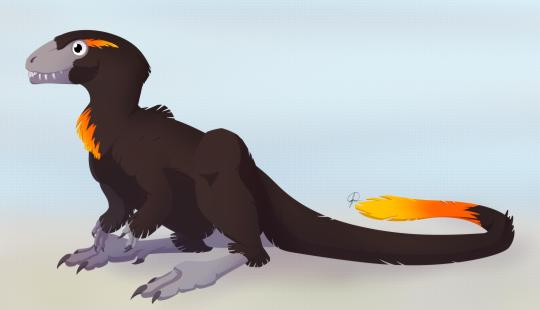
By José Carlos Cortés
Etymology: Demon Reptile
First Described By: Sues et al., 2011
Classification: Dinosauromorpha, Dinosauriformes, Dracohors, Dinosauria, Saurischia, Eusaurischia, Theropoda
Status: Extinct
Time and Place: Between 205 and 202 million years ago, in the Rhaetian of the Late Triassic

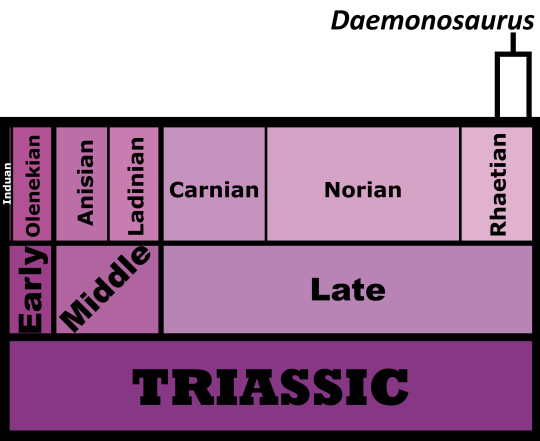
Daemonosaurus is known from the Siltstone Member of the Chinle Formation in New Mexico
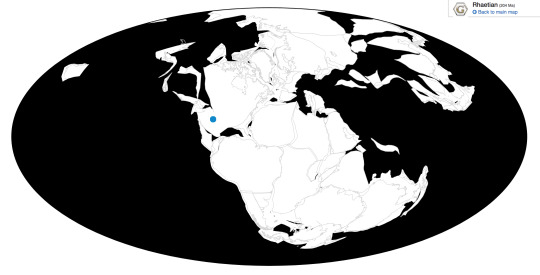
Physical Description: Daemonosaurus is an interestingly little dinosaur, and an enigmatic one, with its placement within the dinosaur family tree holding significant importance for how dinosaurs organize themselves in their initial diversification. This was a small, bipedal dinosaur, only about 1.5 meters long and weighing no more than 22 kilograms. While its body was relatively normal of a dinosaur at that time - longer legs than arms, arms built for grasping, long tail and stout torso - its head was downright bizarre. The skull was very short and box-like, rather than long and narrow or long and rectangular like other predatory dinosaurs of the time. Daemonosaurus also featured very long and large teeth in the upper jaw, and teeth that projected forward out of the mouth from both jaws - in short, it looked fairly buck-toothed. It also had a slight notch in its jaws, which could have been used to grab hold of struggling food and trap it there. It also might be an example of paedomorphy - while the head seems fairly juvenile (including rather big eyes), the rest of the body has the fused bones of an adult. As a small dinosaur, Daemonosaurus would have been covered in fluffy protofeathers for thermoregulation.
Diet: Daemonosaurus would have primarily eaten small animals like early mammals and smaller reptiles, though baby dinosaurs from other species wouldn’t have been off the menu.
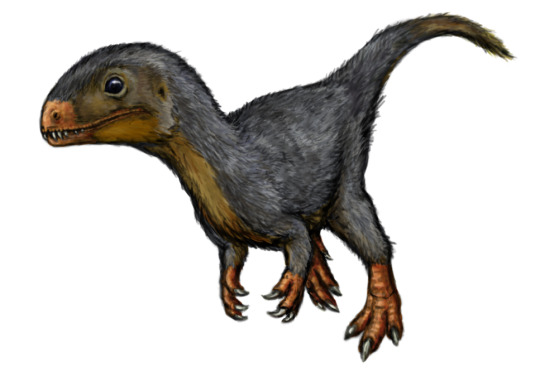
By Michael B. H., CC BY-SA 3.0
Behavior: Daemonosaurus, being a smaller theropod, wouldn’t have been a very bold predator. Instead, it probably waited in the shadows and undergrowth a lot, looking for a moment to strike at its prey. Hiding in the bushes, it was able to stay safe from larger predators, which frequented the environment. It probably would use its hands and mouth to grab struggling prey, and also defend itself from danger. With its very large eyes, it’s even possible it was somewhat nocturnal, and did most of its hunting in the safety of night. It probably took care of its young, though of course without fossil evidence of such it is hard to tell; and it would have been a fairly active, intelligent animal in its habitat.
Ecosystem: Daemonosaurus lived in the Siltstone Environment of the Chinle Formation, a famous ecosystem showcasing the rise of dinosaurs within North America at the end of the Triassic Period. Daemonosaurus is known from one of the later ecosystems of that formation, which makes its position as a fairly basal theropod somewhat surprising. This was a seasonally arid floodplain, with trivers that would occasionally flood and alternate between that and drying up completely. As such, the plantlife around the floodplain was mostly hardy ferns, ginkgoes, horsetails, and cycads - as well as a fairly dense forest of pine and other coniferous trees. Here Daemonosaurus shared its environment with many other Triassic weirdos, such as the Drepanosaur (lizard-monkey thing) Avicranium, ray-finned fish such as Hemicalypterus and Lophionotus, the phytosaur Redondasaurus, the small Aetosaur Stenomyti; and other Dinosauromorphs. There was the Silesaurid Eucoelophysis, the Lagerpetid Dromomeron, and another theropod dinosaur, Ceolophysis.
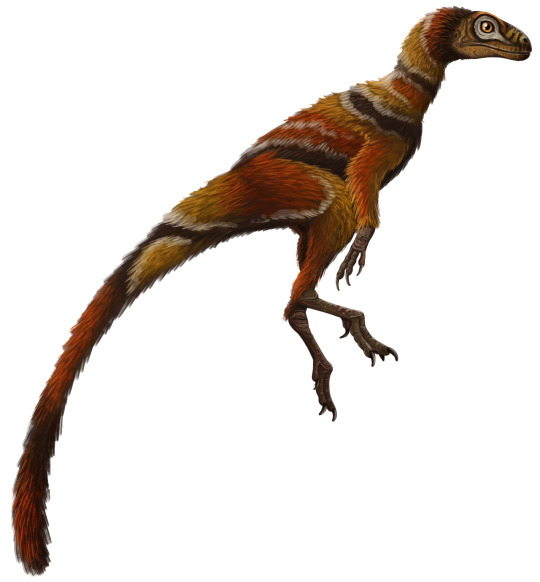
By Scott Reid
Other: Is Daemonosaurus a theropod? Probably. But its head is so weird - and its whole body, too - that the position of Daemonosaurus is a question within the early diversification of dinosaur group. Indeed, Daemonosaurus often changes how a phylogenetic tree turns out. This weirdness is something to keep an eye on for now, because the jury is still out - though basal theropod seems likely. And what a weird theropod lineage it represents!
~ By Meig Dickson
Sources under the Cut
Barta, D. E., S. J. Nesbitt, M. A. Norell. 2018. The evolution of the manus of early theropod dinosaurs is characterized by high inter- and intraspecific variation. Journal of Anatomy 232: 80 - 104.
Ezcurra, M.D. (2006). "A review of the systematic position of the dinosauriform archosaur Eucoelophysis baldwini Sullivan & Lucas, 1999 from the Upper Triassic of New Mexico, USA." Geodiversitas, 28(4):649-684.
Griffin, C. T. 2019. Large neotheropods from the Upper Triassic of North America and the early evolution of large theropod body sizes. Journal of Paleontology: 1 - 21.
Irmis, R. B. 2005. The vertebrate fauna of the Upper Triassic Chinle Formation in northern Arizona. p. 63-88. in S.J. Nesbitt, W.G. Parker, and R.B. Irmis (eds.) 2005. Guidebook to the Triassic formations of the Colorado Plateau in northern Arizona: Geology, Paleontology, and History. Mesa Southwest Museum Bulletin 9.
Nesbitt, S.J., Irmis, R.B., and Parker, W.G. (2005). "A critical review of the Triassic North American dinosaur record." In Kellner, A.W.A., Henriques, D.D.R., & Rodrigues, T. (eds.), II Congresso Latino-Americano de Paleontologia de Vertebrados, Boletim de Resumos. Rio de Janeiro: Museum Nacional/UFRJ, 139.
Sues, H.-D., S. J. Nesbitt, D. S. Berman, A. C. Henrici. 2011. A late-surviving basal theropod dinosaur from the latest Triassic of North America. Proceedings of the Royal Society B 278 (1723): 3459 - 3464.
Sullivan, C., X. Xu. 2016. Morphological Diversity and Evolution of the Jugal in Dinosaurs. The Anatomical Record 300 (1): 30 - 48.
Weishampel, David B.; Dodson, Peter; and Osmólska, Halszka (eds.): The Dinosauria, 2nd, Berkeley: University of California Press. 861 pp. ISBN 0-520-24209-2.
#Daemonosaurus chauliodus#Daemonosaurus#Dinosaur#Theropod#Prehistoric Life#Paleontology#Palaeoblr#Factfile#Prehistory#Carnivore#Triassic#North America#Theropod Thursday#dinosaurs#biology#a dinosaur a day#a-dinosaur-a-day#dinosaur of the day#dinosaur-of-the-day#science#nature
320 notes
·
View notes
Text
The abstract (bolding mine):
“Reptiles first radiated into oceanic environments after the cataclysmic end-Permian mass extinction (EPME), 251.9 million years (Ma) ago. The geologically oldest fossils evincing this adaptive transition have been recovered from upper-Lower Triassic (lower Spathian) strata, ∼248.8 Ma, and postdate a landmark turnover of amphibian-dominated to reptile-dominated marine ecosystems spanning the late Smithian crisis (LSC), ∼249.6 Ma — less than ∼2.3 Ma after the EPME. Here, we report ichthyopterygian (the group including ‘fish-shaped’ ichthyosaurians) remains from the Arctic island of Spitsbergen that predate the LSC in later-middle to early-late Smithian deposits up to ∼250 Ma. Unexpectedly, however, their large size and spongy internal bone structure indicate a fully pelagic ichthyopterygian. Given this unambiguous occurrence ∼2 Ma after the EPME, these pioneering seagoing tetrapods can now be feasibly recast as mass extinction survivors instead of ecological successors within the earliest Mesozoic marine predator communities.”
This is a good write up with more context for laypeople:

If you've been following paleo news lately, then you know ichthyosaurs have been screwing with evolution again.
#Posting here so people don’t fall into the weird intelligent design articles that popped up when I went looking for more info#ichthyosaurs#evolution#paleontology
9K notes
·
View notes
Photo
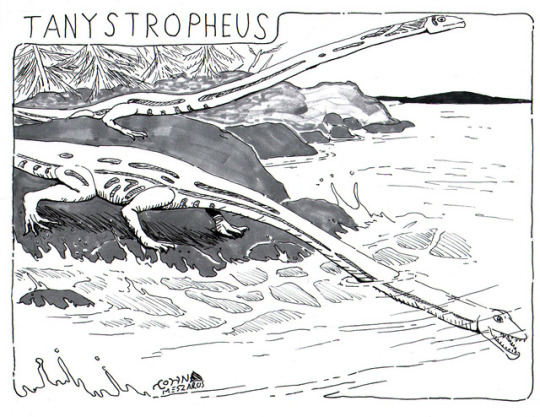
In addition to cryptids, I’m also a huge prehistoric creature nerd. I recently wrote an article for Tracks and Trails, the newsletter of Dinosaur State Park in Rocky Hill, Connecticut where I work.
It’s (hopefully) the first in a series about prehistoric animals of the East Coast of North America
First a little introduction. In the Connecticut Valley, the majority of fossils are trackways. Bones and body fossils of large tetrapods are quite rare with a few exceptions such as the partial remains of Podokesaurus, a Coelophysis relative found near Holyoke, Mass, and the hand and hip bones of the early prosauropods Anchisaurus and Ammosaurus (there are, however, abundant full-body fossils of Jurassic fish, but that's an article for another time).
Tetrapod bones have, however, been found in a number of other Triassic-Jurassic rift valleys along the East Coast. Since these valleys all date from the same time period- during the break-up of Pangea- it is highly likely that these creatures also inhabited the Connecticut Valley.
There are a lot of interesting fossils along the Atlantic Coast, but I only had so much space for the article. So I decided to spread it out into several pieces covering groups of related animals. This first article talks about the Tanystropheids, a diverse group of reptiles with unusually long necks.
I also did a couple black-and-white illustrations of the creatures I talk about. It's nice to finally be getting back to some paleoart after such a long hiatus.
Anyway, without further ado:
TRIASSIC FOSSILS OF THE EAST COAST: THE LONG-NECKED REPTILES
by John Meszaros
The Triassic period can be thought of as a time of “evolutionary experimentation”. The preceding Permian Age ended with a massive extinction event- the largest known extinction in Earth’s history, in fact- that wiped out ninety percent of life on Earth. In the wake of this Great Dying, innumerable ecological niches were left vacant. Life evolved to take fill these gaps, often in forms that seem bizarre to us in the modern day.
Although evidence of Triassic life is rare in Connecticut, fossils from other sites along the East Coast of North America allow us to construct a reasonably accurate picture of the animals that would have lived here. Dinosaur State Park’s Triassic diorama and its accompanying background painting by William Sillin depict a few of these prehistoric creatures: the crocodile-like Rutiodon; the giant amphibian Metaposaurus; bearded dragonesque Hypsognathus; pig-nosed Stegomus and the early dinosaurs Coelophysis and Sileasaurus. These are but a small sample, however, of the unique and unusual Triassic beasts lying buried in rocks all along the Atlantic coast.
One of the more distinctive reptiles of the Triassic was Tanystropheus (Greek for “long vertebrae”). Sometimes described as a “living fishing pole”, this creature was characterized by its extremely long neck- at 10 feet, it was longer than the rest of the animal’s body and tail combined. Despite this length, however, Tanystrophus's neck had only 12 elongated vertebrae. The exact reason for this strange anatomy is not known, but since fossils of Tanystropheus are usually found near marine sediments, it is speculated that the animal hunted for fish from the shore by dipping its head and neck into the shallows.
Tanystropheus bones are known primarily from Europe, the Middle East and China. However, in 2014 paleontologists Paul Olsen and Hans-Dieter Sues described the discovery of a single Tanystropheus neck vertebra from the coast of Nova Scotia along the Bay of Fundy, thus establishing the presence of these reptiles on our side of the Atlantic. This is actually not that surprising considering that during the Triassic the lands that would become North America and Europe were close together within the super-continent Pangea.

In contrast to the single Tanystropheus bone from Nova Scotia, fossils of its smaller cousin, Tanytrachelos, are abundant in fossil sites along the East Coast- primarily in the Solite Quarry of Virginia. Nine-inch long Tanytrachelos resembled a long-necked lizard with powerful webbed hind legs that it used to kick-swim in a frog-like manner through the shallow lakes of the Triassic rift valleys. It likely fed on aquatic insects, which are themselves abundantly preserved in fine detail at the Solite Quarry. Tanytrachelos is thought to be the maker of a type of fossil footprint called Gwyneddichnium, found abundantly in Triassic sandstones from Pennsylvania. It is, of course, not possible to determine exactly what creature made these tracks- just as it is not possible to say definitively that Dinosaur State Park’s own Eubrontes tracks were made by Dilophosaurus. However, the foot structure of Tanytrachelos is a close match to Gwyneddichnium, making it- or a very similar reptile- the most likely candidate.
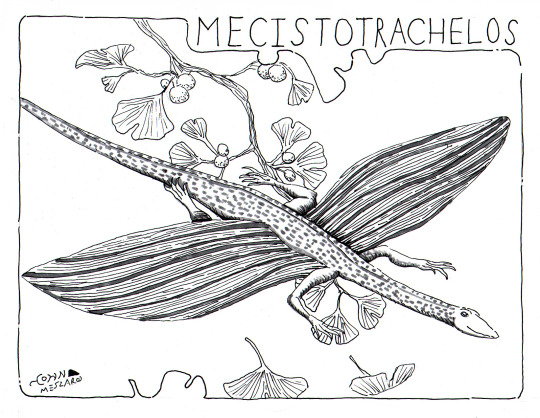
The same Virginia quarry where Tanytrachelos fossils are so abundant has also yielded fossils of another possible Tanystropheus cousin, the gliding lizard Mecistotrachelos . This creature lived among the boughs of the ancient forests, hunting insects and sailing from tree to tree on wings formed from elongated ribs much like those of the “flying lizard” Draco volans of South-east Asia.
Mecistotrachelos shared the Triassic skies with a number of similar wing-ribbed gliding reptiles, including Kuehneosaurus (known from fossils found in southwestern England) and Icarosaurus (known from a single specimen unearthed in New Jersey). It differed from these other gliding lizards in a few ways. For one thing, it had an elongated neck similar to Tanystropheus- though its neck was much less exaggerated than the “fishing rod” of the latter animal Mecistotrachelos also appears to have had better maneuverability in the air than its contemporaries. The base of the first wing-ribs were significantly thickened- much thicker, in fact, than the leading ribs in other gliders. This suggests that they may have been anchors for strong muscles that would have allowed the creature to flex its wings, giving it the ability to bank and alter its direction as it descended.
Mecistotrachelos is notable for being the first fossil to be analyzed with a CT scanner- a necessity since the skeleton was too delicate to be removed from its stony grave through typical paleontological procedures.
Though none of the species discussed here have yet been found in the Connecticut Valley, as was said before, the presence of these fossils in other East Coast fossil Triassic river valleys gives good evidence that frog-like Tanytrachelos once swam the waters of our state in the shadows of the predatory phytosaurs whilst wing-ribbed Mecistotrachelos glided through the gingkos and conifers along the shores. And where the rivers met the sea, it is quite possible that there were Tanystropheus dipping their fishing-pole necks into the surf to snap up fish.
REFERENCES
Window Into The Jurassic World by Nicholas G. MacDonald
Dawn of the Dinosaurs: Life In The Triassic by Nicholas Fraser, illustrated by Douglas Henderson
The Great Rift Valleys of Pangea in Eastern North America: Sedimentology, Stratigraphy and Paleontology (Volume 2) edited by Peter M. LeTourneau and Paul E. Olsen
Last Days Of Pangea: In The Footsteps Of Dinosaurs by Daniel T. Ksepka and Kate Dzikiewicz
(This is a slim informational booklet to accompany an exhibit on Triassic fossils at the Bruce Museum in Greenwich, CT)
An article on Mecistotrachelos from National Geographic
Quantitative Taphonomy of a Triassic Reptile: Tanytrachelos ahynis from the Cow Branch Formation, Dan River Basin, Solite Quarry, Virginia. Michelle M. Casey. Master's Thesis in Geosciences. 2005 Virginia Polytechnic Institute and State University
Stratigraphy, Sedimentology and Paleontology of the Upper Triassic Solite Quarry, North Carolina and Virginia. Cynthia M. Liutkus-Pierce, Nicholas C. Fraser and Andrew D. Heckert. Geological Society of America Field Guides 2014; 35; 255-269
Stratigraphic and Temporal Context and Faunal Diversity of Permian-Jurassic Continental Tetrapod Assemblages from the Fundy Rift Basin, Eastern Canada. Hans-Dieter Sues and Paul E. Olsen. Atlantic Geology 51; 2015; 139-205
13 notes
·
View notes
Text
April Fools 2017: Solved Paleo Mysteries Day
With Unsolved Mysteries Month over, and the first day of April upon us, it’s time for an important announcement: after many hours of grueling research, I’ve managed to solve every single one of the past month’s mysteries.
So, in no particular order:
Horse Snoots As we all know, weird noses are always trunks.

Ichthyoconodon There’s only one logical explanation.
Mosasaurs Mosasaurs were in fact the sister group to sauropodomorphs.
Amiskwia & Typhloesus Lichens.
Kakuru As recent discoveries like Deinocheirus and Spinosaurus have shown us, dinosaurs previously known only from fragmentary remains always turn out to be utterly ridiculous-looking and weirdly proportioned. Thus we have to go much much weirder to have a chance of ever predicting what Kakuru really looked like.
Paleodictyon DEEP SEA BEES
Godzillus An ancient kraken’s art project. It may have been a crude attempt at a self-portrait sculpture.

Trilobites Despite their apparent biological complexity, trilobites are really just naturally-occurring inorganic structures.
Diskagma Proterozoic macroviruses.
Acallosuchus Actually a giant tenrec.

Ammonites The lack of soft tissue is immediately explained if we reconsider ammonites as shelled ghosts. (Modern ghosts are of course secondarily shell-less.)
Chitinozoans Early skyfish eggs. Their disappearance from the marine fossil record marks not an extinction but their evolutionary transition to an entirely aerial lifestyle.
Maxberg Archaeopteryx While most specimens of Archaeopteryx are elaborate hoaxes, to the surprise of everyone the Maxberg specimen was actually a genuine fossil -- it just wasn’t a dinosaur. Further preparation of the slab after the casts were made found traces of the missing parts of its body, a discovery that had to be quickly covered up.
Pterosaurs Transitional pterosaurs went through a highly unusual “assisted flight” stage.

Vetulicolians The long sought-after transitional forms between crustaceans and fish.
Dinosaur Snoots Weird noses are ALWAYS trunks.

Permian Extinction “average extinction rate of 70% of all species” factoid actualy just statistical error. average extinction rate of 0% of all species. Lystrosaurus georg, who lives in early Triassic & displaces over 10,000 terrestrial vertebrates each day, is an outlier adn should not have been counted
Ediacarans The Ediacaran biota seems so strange and alien in comparison to all other known groups because they really weren’t related at all to any modern organisms. They were actually the very last native lifeforms of this planet, wiped out after the arrival of our invasive extraterrestrial ancestors.
Andrewsarchus Upon closer inspection of the nasal region of the skull, it turns out Andrewsarchus was a rhinogradentian.
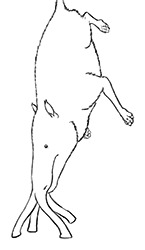
Gluteus Preserved three-dimensional cross-sections of ancient extra-dimensional beings. Upper Devonian spacetime in Iowa was unusually “sticky”, trapping these odd manifestations within our universe.
Bats My own independent analysis recovers bats as highly modified armadillos. Also, through rigorous application of digital image enhancement, I have discovered many previously unseen anatomical features in photographs of fossil bats, and can now accurately reconstruct their ancestral form:

Amphicoelias Clearly no terrestrial animal could grow so huge and still be able to support its own weight. Sauropods that large would have inevitably begun to collapse under their own gravity, shedding most of their outer layers in a sudden explosion and scattering rare heavy elements around their immediate vicinity. (This is the primary reason we only find isolated bones of giant sauropods and no complete skeletons.)
The very largest individuals would also have occasionally become just massive enough to potentially collapse past their Schwarzschild radius and form an unstable saurosingularity -- which would have then violently evaporated via Hawking radiation with an energy output equivalent to a small comet impact.
And that’s why no animals get that big anymore.
#april fools#solving the unsolved mysteries#unreality tw#weird noses are always trunks#everything is a tenrec#panspermia#rhinogradentia#cryptozoology#batadillos#saurosingularities
101 notes
·
View notes
Text
FossilWatch: Stats, sex, skulls and sleep
Sleeping through tough times
US scientists have discovered fossil evidence of a hibernation-like state in an animal that lived in Antarctica during the Early Triassic, some 250 million years ago.
It is the oldest such find, they say, and suggests that torpor – a general term for hibernation and similar states in which animals temporarily lower their metabolic rate to get through a tough season – arose in vertebrates even before mammals and dinosaurs evolved.
The creature, a member of the genus Lystrosaurus, was a distant relative of mammals.
It spread across Earth’s then-single continent, Pangea, and fossils have been found in India, China, Russia and Africa, as well as Antarctica, which at the time experienced extended periods without sunlight each winter.
Life restoration of Lystrosaurus in a state of torpor. Credit: Crystal Shin
“Animals that live at or near the poles have always had to cope with the more extreme environments present there,” says lead author Megan Whitney. “These preliminary findings indicate that entering into a hibernation-like state is not a relatively new type of adaptation. It is an ancient one.”
Whitney carried out the work while at the University of Washington, with then colleague Christian Sidor. Their findings are published in the journal Communications Biology.
Lystrosaurus had no teeth but bore a pair of tusks in the upper jaw, Witney says, which made their study possible. As in elephants, the tusks grew continuously, so cross-sections of fossilised tusks provide information about metabolism, growth and stress or strain.
The researchers compared tusks from six Antarctic Lystrosaurus and four from South Africa and noticed similar growth patterns but one key difference: closely-spaced, thick rings that likely indicate periods of less deposition due to prolonged stress.
“The closest analogue we can find to the ‘stress marks’ that we observed… are stress marks in teeth associated with hibernation in certain modern animals,” Whitney says.
The face of a dinosaur embryo
The first dinosaur embryos were found in a nesting ground of titanosaurian at Auca Mahuevo in Argentinian Patagonia. Two decades later, an international research team has described the first near-intact embryonic skull.
A magnified perspective of the Titanosaurian embryonic skull and a skull reconstruction. Credit: Kundrat et al
The findings, published in the journal Current Biology, suggest that sauropod dinosaurs, a group characterised by the long neck and tails and small heads familiar in the Brontosaurus, may have had specialised facial features as hatchlings that changed as they grew into adults.
“The most striking feature is head appearance, which implies that hatchlings of giant dinosaurs may differ in where and how they lived in their earliest stages of life,” says lead author Martin Kundrat of Pavol Jozef Šafárik University, Slovak Republic.
“But because it differs in facial anatomy and size from the sauropod embryos of Auca Mahuevo, we cannot rule out that it may represent a new titanosaurian dinosaur.”
Kundrat’s team used an imaging technology called synchrotron microtomography to study the inner structure of bones, teeth and soft tissues of the embryonic dinosaur and found hidden details, including tiny teeth preserved deeply in tiny jaw sockets.
The specimen also is from Patagonia, although its precise origin isn’t known. It was illegally exported and came to researchers’ attention only later. It’s now housed with other embryos from Auca Mahuevo at Argentina’s Museo Municipal Carmen Funes.
Thinking about dinosaur sex
Speaking of dinosaurs, how do you tell boys from girls? The answer may be to use stats.
In a new paper in the Biological Journal of the Linnean Society, scientists led by the Field Museum, US, explain how a different kind of analysis can estimate the degree of sexual variation in a dataset of fossils.
“It’s a whole new way of looking at fossils and judging the likelihood that the traits we see correlate with sex,” says lead author Evan Saitta. “This paper is part of a larger revolution of sorts about how to use statistics in science but applied in the context of palaeontology.”
Palaeontologists have previously used significance testing, where you collect all your data points then calculate the probability that those results could have happened by pure chance rather than an actual cause. This sometimes works for big, clean datasets, Saitta says, but “with a lot of these dinosaur tests, our data is pretty bad”.
He and his colleagues turned to effect size statistics, which attempts to estimate the degree of sex differences and calculate the uncertainty in that estimate. This approach takes natural variations into account without viewing dimorphism as black-or-white. Many sexual dimorphisms can be subtle.
“We showed that if you adopt this paradigm shift in statistics, where you attempt to estimate the magnitude of an effect and then put error bars around that, you can often produce a fairly accurate estimate of sexual variation even when the sexes of the individuals are unknown,” says Saitta. The work continues.
Old fossil adds to old debate
US and Canadian researchers have uncovered fossils of a new species of marine animal, Gyaltsenglossus senis, that could help solve a longstanding debate.
Credit: Jean-Bernard Caron. Royal Ontario Museum
Discovered at a Burgess Shale site in the Canadian Rockies, they are over 500 million years old and just two centimetres in length, but the remarkably preserved soft tissues reveal incredibly detailed anatomical structures.
These details include the oval-shaped proboscis of acorn worms (aka enteropneusta) and a basket of feeding tentacles similar to those of pterobranchs. And that’s where things get interesting, because this provides evidence connecting these two major groups of hemichordates.
“Acorn worms and pterobranchs look so different from each other that understanding the origins of their evolutionary relationship has been a major historical question in zoology,” says Karma Nanglu from the Smithsonian National Museum of Natural History, lead author of a paper in the journal Current Biology.
“Answering this question has been made much harder by the extreme lack of fossils of these soft-bodied hemichordates. Throughout the half-billion-year-long history of hemichordates you can count on one hand the number of exceptional preserved fossil species.”
An ancient animal with an intermediary anatomy between acorn worms and pterobranchs had been hypothesised before but “this new animal is the clearest view of what the ancestral hemichordate may have looked like,” says co-author Christopher Cameron, from the University of Montreal.
Hemichordates belong to a major division of animal life called Deuterostomia, which includes chordates like fish and mammals. When looking at Gyaltsenglossus, we’re actually looking at a very, very distant relative of our own branch of vertebrate and human evolution, Nanglu says.
FossilWatch: Stats, sex, skulls and sleep published first on https://triviaqaweb.weebly.com/
0 notes
Photo

RARE Reptile Coprolite with Fish Bones | Upper Triassic Fossil | Aust Cliff Bristol UK | Westbury Formation | Certified Specimen
This listing features a RARE small reptile coprolite fossil with visible fish bone inclusions, discovered from the renowned Aust Cliff locality in Bristol, UK. This exceptional trace fossil comes from the Westbury Formation, part of the Penarth Group, and dates to the Upper Triassic Period, approximately 208–201 million years ago.
Discovered by our team members Alister and Alison on 07 April 2025, this coprolite has been carefully cleaned, prepped, and treated by Alison, ensuring both scientific integrity and display quality.
Geological Context:
Fossil Type: Coprolite (fossilised faeces)
Likely Producer: Small Triassic reptile, possibly a fish-eating sphenodontian or early crocodylomorph
Inclusions: Clearly visible fish bones and scales preserved in matrix
Location: Aust Cliff, Bristol, UK
Formation: Westbury Formation
Group: Penarth Group
Geological Period: Upper Triassic
Depositional Environment: Shallow marine to marginal lagoonal setting with periodic terrestrial input – conducive to fossil preservation of organic-rich material like excrement
Notable Features & Scientific Importance:
This coprolite exhibits remarkable preservation, including bone fragments and fish scale inclusions, providing insight into the diet and ecosystem interactions of Triassic reptiles.
Trace fossils such as this are invaluable for reconstructing palaeoecological dynamics and food webs.
The Aust Cliff site is internationally recognised for its Triassic-Jurassic boundary exposures, yielding important fossils including marine reptiles, invertebrates, and trace fossils.
Palaeontological Classification (trace fossils): While coprolites are classified as ichnofossils (trace fossils) rather than body fossils, their morphological analysis and inclusions allow identification of likely producers and depositional context.
All of our Fossils are 100% Genuine Specimens & come with a Certificate of Authenticity.
Scale cube = 1cm: Please refer to the photo for exact sizing. The fossil shown is the actual specimen you will receive—authentic, ethically sourced, and scientifically prepared.
#coprolite fossil#reptile coprolite#Aust Cliff fossil#Westbury Formation#Penarth Group#Upper Triassic fossil#fish bone coprolite#UK fossil#certified coprolite#genuine Triassic specimen#reptile dung fossil#fossil excretion with inclusions#Alister and Alison fossil find
0 notes
Photo

Ceratodus Fossil Coprolites – Upper Triassic – Aust Cliff, Westbury Formation, UK – Authentic Specimen
Ceratodus Coprolite Fossils in Matrix – Upper Triassic – Aust Cliff, Westbury Formation, Penarth Group, Bristol, UK
This listing features a genuine fossil coprolite specimen, attributed to the prehistoric lungfish Ceratodus, embedded in original matrix from the famous fish, reptile, and coprolite bed at Aust Cliff, near Bristol. This site is part of the Westbury Formation, a classic Upper Triassic locality in the UK known for its rich vertebrate fossil content.
Scientific & Geological Details:
Location: Aust Cliff, Bristol, England, UK
Formation: Westbury Formation
Group: Penarth Group
Age: Upper Triassic (~205–210 million years ago)
Depositional Environment: Lagoonal to marginal marine with periodic anoxic conditions—ideal for preservation of vertebrate remains and trace fossils
Fossil Zone: Part of the Rhaetian Stage, marking the transition to the Jurassic
Notable Species: Ceratodus was a genus of lungfish, a group that still survives today in limited forms. These fish were adapted to low-oxygen waters and left behind spiral or pellet-like faecal fossils.
Morphological Features of the Coprolite:
Typically cylindrical or spiral in form
Surface texture may show subtle spiral markings (if not abraded)
Matrix may contain associated microvertebrate remains including fish scales or bone fragments
Represents trace fossil evidence (not the animal itself but its biological activity)
Specimen Information:
Discovery Date: 07 April 2025
Collected By: UKGE team members Alister and Alison
Preparation: Expertly cleaned and stabilised by Alison
Scale Reference: Shown alongside a 1cm cube for exact sizing – see photographs for dimensions and angles
What You See Is What You Get: The photos show the exact item you will receive
Authenticity: Supplied with a Certificate of Authenticity. All our fossils are 100% genuine and responsibly sourced.
Educational and Collectible Value:
This coprolite offers a fascinating window into ancient biological processes and Triassic ecosystems. It's a perfect specimen for collectors, educators, students, and anyone interested in paleobiology or the evolution of vertebrate life. Trace fossils like this are invaluable for reconstructing diet and environmental conditions of ancient species.
#fossil coprolite#Ceratodus coprolite#Upper Triassic fossil#Aust Cliff fossil#Westbury Formation#Penarth Group#fish coprolite#lungfish fossil#ancient fish droppings#genuine fossil#prehistoric fish#UK fossil bed#coprolite specimen#fossilised faeces#vertebrate trace fossil
0 notes
Photo

RARE Fossil Ceratodus Coprolite with Reptile Bones Westbury Formation Triassic Aust Cliff Bristol UK Authentic
This listing features a rare and highly sought-after fossil coprolite (fossil poo) attributed to the prehistoric lungfish genus Ceratodus, preserved within a fossil-rich block containing reptile bone fragments. The specimen was discovered by our expert team (Alister & Alison) on 07 April 2025 at the renowned Aust Cliff, Bristol, from the Westbury Formation, Penarth Group, dating to the Upper Triassic period (~208 million years ago).
The Westbury Formation at Aust Cliff is internationally famous for its fish, reptile and coprolite bed, a layer of sediment rich in vertebrate remains deposited in a lagoonal to marginal marine environment during the final stages of the Triassic. This locality marks the transition between the Triassic and Jurassic periods and has yielded numerous important fossils.
About Ceratodus & This Coprolite:
Genus: Ceratodus (prehistoric lungfish)
Fossil Type: Coprolite with visible inclusions of bone and possible scale fragments
Morphology: Elongated cylindrical coprolite with surface impressions, fine preservation of inclusions
Preservation: The coprolite is mineralised, likely composed of calcium phosphate, showing embedded reptilian bone debris, which may have been ingested
Reptile Bone Inclusions:
Small fossil bone fragments embedded within or alongside the coprolite
May originate from small reptiles or amphibians inhabiting the same depositional environment
Geological & Scientific Details:
Species Attribution: Ceratodus sp. (coprolite producer)
Geological Formation: Westbury Formation
Group: Penarth Group
Depositional Environment: Marginal marine to lagoonal (low oxygen, promoting fossil preservation)
Geological Age: Upper Triassic (Rhaetian Stage)
Biozone: Rhaetian Vertebrate Bed (informal, Aust Cliff local faunal assemblage)
Location: Aust Cliff, Bristol, United Kingdom
This fossil not only showcases a fascinating example of prehistoric digestive processes but also preserves part of the food web from the Triassic ecosystem. Specimens with multiple fossil elements from this famous bed are rarely available.
The photo shows the actual specimen you will receive. Scale cube = 1cm. For full sizing, please see the image.
All of our Fossils are 100% Genuine Specimens & come with a Certificate of Authenticity.
Carefully selected, professionally cleaned and prepped by Alison, this is an exceptional collector's item from a site of international palaeontological significance.
#Ceratodus coprolite#fossil fish poo#reptile bone fossil#Aust Cliff fossil#Westbury Formation#Penarth Group#Upper Triassic fossils#coprolite with bone fragments#UK vertebrate fossil#fish coprolite#fossil faeces#Triassic coprolite#Ceratodus tooth#lungfish coprolite#ancient reptile bone#fossil bone block#Bristol fossil site
0 notes
Photo

Fossil Reptile Bones & Coprolite – Upper Triassic – Aust Cliff, Westbury Formation, Bristol UK
Fossil Reptile Bones and Coprolite in Matrix – Upper Triassic – Aust Cliff, Westbury Formation, Bristol, UK
This exceptional block contains genuine reptile bone fragments and an accompanying coprolite (fossilised faeces), preserved together in a matrix from the world-famous fish, reptile, and coprolite bed at Aust Cliff, Bristol. This geological unit, known as the Westbury Formation, is part of the Penarth Group and dates back to the Upper Triassic Period (around 205–210 million years ago).
Scientific and Geological Context:
Location: Aust Cliff, near Bristol, UK
Formation: Westbury Formation
Group: Penarth Group
Geological Period: Upper Triassic
Depositional Environment: Coastal lagoon/estuarine system subject to episodic flooding and anoxic conditions, perfect for preservation of organic material
Lithology: Dark laminated mudstones and siltstones with fossil-rich horizons
Palaeoecology: Rich with vertebrate remains including fish, early marine reptiles (e.g. placodonts and ichthyosaurs), and evidence of terrestrial vertebrate activity via coprolites and bone beds
Fossil Features and Significance:
The coprolite is thought to originate from a carnivorous vertebrate and often contains inclusions such as crushed bone fragments, giving insights into the diet of Triassic predators. The reptile bones in this block may represent fragments from marine or marginal marine reptiles that inhabited or were washed into the depositional basin.
Morphology Highlights:
Long, cylindrical coprolite with preserved texture and mineral replacement
Bone fragments exhibit porous internal structure typical of vertebrate remains
Notable Use: Coprolites from this bed are significant for palaeoecological reconstructions and are used to study trophic chains in Late Triassic environments
Specimen Details:
Discovered by: Our own team – Alister and Alison – on 07 April 2025
Cleaned, prepped and treated by: Alison
Scale Reference: Cube in image = 1cm; full size detailed in photographs
Authenticity: Supplied with a Certificate of Authenticity – we guarantee all our specimens are 100% genuine
Photographed Specimen: What you see is exactly what you get – carefully chosen, clearly shown
Why This Specimen?
This is an ideal piece for collectors, educators, and anyone with an interest in prehistoric life. With both reptile bone and coprolite in situ from a stratigraphically and scientifically important UK fossil bed, it’s a rare and insightful snapshot of Triassic life.
#fossil reptile bones#Triassic coprolite#Aust Cliff fossil#Westbury Formation fossil#Penarth Group#reptile coprolite#Upper Triassic fossil#genuine fossil#UK fossil bed#dinosaur-era fossils#fish reptile coprolite bed#fossil block#authentic fossil bones#British fossil
0 notes
Photo

RARE Fossil Reptile Bones and Coprolite – Aust Cliff UK – Upper Triassic Westbury Formation
RARE Fossil Reptile Bones and Coprolite – Westbury Formation, Aust Cliff, Bristol, UK – Upper Triassic
This is a carefully selected and authentic fossil slab containing both fossilised reptile bones and coprolite (fossilised faeces), recovered from the famous fish, reptile, and coprolite bed at Aust Cliff, Bristol. This site is one of the most scientifically significant Upper Triassic fossil localities in the UK.
Formation and Age:
Location: Aust Cliff, Bristol, UK
Geological Unit: Westbury Formation, Penarth Group
Stratigraphy: Upper Triassic (~208–201 million years ago)
Depositional Environment: Shallow marine to lagoonal – ideal for fossil preservation
Fossil Content and Scientific Context:
The coprolite is likely from Ceratodus, an extinct genus of lungfish, while the reptile bones may belong to small Triassic marine or semi-aquatic reptiles, such as early archosaurs. Fossils from this bed often preserve dietary and environmental data, making them important for scientific and educational purposes.
This block offers a rare opportunity to own multiple fossil types in one piece, showcasing the diverse ecosystem that existed in the Late Triassic coastal regions of Britain.
Features and Morphology:
Reptile bones typically show dark mineralisation with fine surface detail
Coprolite may exhibit spiral or segmented morphology consistent with lungfish
Contrasting matrix and fossil material provide a striking visual display
Authenticity and Preparation:
Discovered by our own field team (Alister and Alison) on 07 April 2025
Cleaned, prepped and treated by Alison to ensure stability and clarity
All fossils are 100% genuine and come with a Certificate of Authenticity
Scale cube = 1cm. Please refer to photos for full sizing
The specimen shown in the photograph is the exact item you will receive
Why Buy From Us:
We specialise in high-quality, scientifically interesting fossil specimens that are responsibly sourced and professionally prepared. Perfect for collectors, educators, or anyone looking to own a genuine piece of natural history.
#Fossil Reptile Bone#Coprolite#Aust Cliff Fossil#Westbury Formation#Upper Triassic Fossil#Penarth Group#UK Fossil#Genuine Fossil with Certificate#Bristol Fossils#Reptile Coprolite#Triassic Reptile Fossil#Fish Reptile Coprolite Bed#Authentic Prehistoric Fossil#Dinosaur Era Fossil
0 notes
Photo

Fossil Fish Tooth – Upper Triassic – Aust Cliff, Westbury Formation, Bristol UK – Genuine Specimen
Fossil Fish Tooth in Matrix – Upper Triassic – Aust Cliff, Westbury Formation, Penarth Group, Bristol, UK
This listing features an authentic fossil fish tooth preserved in matrix, originating from the iconic fossil-bearing bed at Aust Cliff, Bristol. This site is internationally recognised for its rich accumulation of fish, reptile, and coprolite remains from the Upper Triassic period, particularly within the Westbury Formation of the Penarth Group.
Geological & Scientific Context:
Locality: Aust Cliff, Bristol, UK
Stratigraphy: Westbury Formation, Penarth Group
Age: Upper Triassic (~205–210 million years ago)
Depositional Environment: A marginal marine estuarine or coastal lagoon setting with periodic anoxic conditions. These created ideal preservation conditions, capturing a moment in time from a biologically diverse late Triassic ecosystem.
Lithology: Laminated, organic-rich black mudstones with bone and tooth-rich concentrations
Fossil Description & Features:
The specimen displays a clearly defined fish tooth embedded within a natural matrix, offering a glimpse into the feeding anatomy of prehistoric fishes. Likely candidates for attribution include Saurichthys, Lepidotes, or Palaeoniscid fish—all of which are known from this formation.
Morphology:
Conical or lanceolate shape typical of piscivorous species
Smooth enamel surface, occasionally striated, with tapering to a fine point
Root occasionally visible, though often encased in matrix
Palaeontological Significance:
Teeth from this bed are essential in studying the evolution and dietary adaptations of early ray-finned fishes and predatory actinopterygians
The fossil record from Aust Cliff helps reconstruct the dynamics of Triassic vertebrate communities just before the major Jurassic radiation
Specimen Details:
Discovery Date: 07 April 2025
Discovered by: Our own field team members, Alister and Alison
Preparation & Treatment: Cleaned and stabilised by Alison
Scale Reference: Shown with 1cm cube – please refer to photographs for full sizing and angles
Authenticity: Comes with a Certificate of Authenticity – all of our fossils are 100% genuine and responsibly sourced
What You See Is What You Get: The specimen in the photos is the exact item you’ll receive
Ideal For:
Fossil collectors, educational purposes, museum displays, or anyone with a fascination for marine vertebrates of the prehistoric world. This specimen makes a superb addition to collections focused on Triassic ecosystems, vertebrate paleontology, or evolutionary biology.
#fossil fish tooth#Triassic fish fossil#Aust Cliff fossil#Upper Triassic fossil#Westbury Formation#Penarth Group#fossil fish remains#UK fossil fish#authentic fossil#prehistoric fish tooth#ancient fish jaw#reptile coprolite bed#vertebrate paleontology#real fossil tooth#certificate of authenticity
0 notes